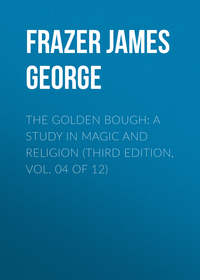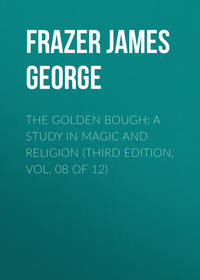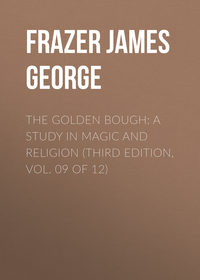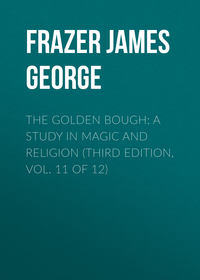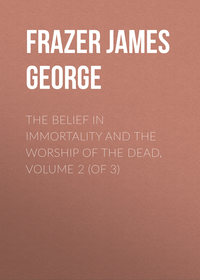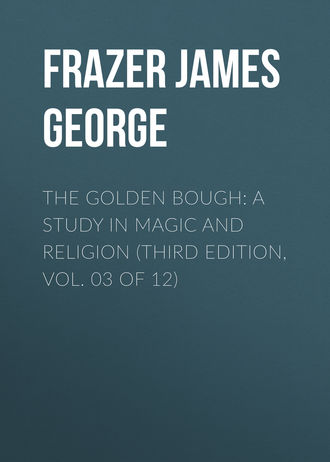 полная версия
полная версияThe Golden Bough: A Study in Magic and Religion (Third Edition, Vol. 03 of 12)
131
G. Kurze, “Sitten und Gebräuche der Lengua-Indianer,” Mitteilungen der Geographischen Gesellschaft zu Jena, xxiii. (1905) p. 18.
132
H. Ling Roth, “Low's Natives of Borneo,” Journal of the Anthropological Institute, xxi. (1892) p. 112.
133
Indian Antiquary, vii. (1878) p. 273; A. Bastian, Völkerstämme am Brahmaputra, p. 127. A similar story is told by the Hindoos and Malays, though the lizard form of the soul is not mentioned. See Panjab Notes and Queries, iii. p. 166, § 679; N. Annandale, “Primitive Beliefs and Customs of the Patani Fishermen,” Fasciculi Malayenses, Anthropology, part i. (April 1903) pp. 94 sq.
134
E. Gerard, The Land beyond the Forest, ii. 27 sq. A similar story is told in Holland (J. W. Wolf, Nederlandsche Sagen, No. 250, pp. 343 sq.). The story of King Gunthram belongs to the same class; the king's soul comes out of his mouth as a small reptile (Paulus Diaconus, Hist. Langobardorum, iii. 34). In an East Indian story of the same type the sleeper's soul issues from his nose in the form of a cricket (G. A. Wilken, in De Indische Gids, June 1884, p. 940). In a Swabian story a girl's soul creeps out of her mouth in the form of a white mouse (A. Birlinger, Volksthümliches aus Schwaben, i. 303). In a Saxon story the soul comes out of the sleeper's mouth in the shape of a red mouse. See E. Mogk, in R. Wuttke's Sächsische Volkskunde2 (Dresden, 1901), p. 318.
135
Shway Yoe, The Burman, ii. 103; M. and B. Ferrars, Burma (London, 1900), p. 77; R. G. Woodthorpe, in Journal of the Anthropological Institute, xxvi. (1897) p. 23; A. Bastian, Die Völker des östlichen Asien, ii. 389; F. Blumentritt, “Der Ahnencultus und die religiösen Anschauungen der Malaien des Philippinen-Archipels,” Mittheilungen der Wiener Geogr. Gesellschaft, 1882, p. 209; J. G. F. Riedel, De sluik-en kroesharige rassen tusschen Selebes en Papua, p. 440; id., “Die Landschaft Dawan oder West-Timor,” Deutsche geographische Blätter, x. 280; A. C. Kruijt, “Een en ander aangaande het geestelijk en maatschapelijk leven van den Poso-Alfoer,” Mededeelingen van wege het Nederlandsche Zendelinggenootschap, xxxix. (1895) p. 4; K. von den Steinen, Unter den Naturvölkern Zentral-Brasiliens, pp. 340, 510; L. F. Gowing, Five Thousand Miles in a Sledge (London, 1889), p. 226; A. C. Hollis, The Masai (Oxford, 1905), p. 308. The rule is mentioned and a mystic reason assigned for it in the Satapatha Brâhmana (part v. p. 371, J. Eggeling's translation).
136
Rev. Lorimer Fison, in a letter to the author dated August 26, 1898.
137
K. von den Steinen, Unter den Naturvölkern Zentral-Brasiliens, p. 340.
138
Hugh Miller, My Schools and Schoolmasters (Edinburgh, 1854), ch. vi. pp. 106 sq.
139
J. L. van der Toorn, “Het animisme bij den Minangkabauer der Padangsche Bovenlanden,” Bijdragen tot de Taal- Land- en Volkenkunde van Nederlandsch-Indië, xxxix. (1890) p. 50.
140
N. Annandale, in Fasciculi Malayenses, Anthropology, part i. (April 1903) p. 94.
141
Panjab Notes and Queries, iii. p. 116, § 530.
142
W. W. Rockhill, “Notes on some of the Laws, Customs, and Superstitions of Korea,” American Anthropologist, iv. (1891) p. 183.
143
W. R. S. Ralston, Songs of the Russian People, pp. 117 sq.; F. S. Krauss, Volksglaube und religiöser Brauch der Südslaven (Münster i. W., 1890), p. 112. The latter writer tells us that the witch's spirit is also supposed to assume the form of a fly, a hen, a turkey, a crow, and especially a toad.
144
Holzmayer, “Osiliana,” Verhandlungen der gelehrten Estnischen Gesellschaft zu Dorpat, vii. (1872) No. 2, p. 53.
145
P. Einhorn, “Wiederlegunge der Abgötterey,” etc., reprinted in Scriptores rerum Livonicarun, ii. 645 (Riga and Leipsic, 1848).
146
A. de Nore, Coutumes, mythes et traditions des provinces de France (Paris and Lyons, 1846), p. 88.
147
A. W. Howitt, Native Tribes of South-East Australia, p. 387.
148
Bringaud, “Les Karens de la Birmanie,” Missions Catholiques, xx. (1888) pp. 297 sq.
149
A. Henry, “The Lolos and other tribes of Western China,” Journal of the Anthropological Institute, xxxiii. (1903) p. 102.
150
C. Hose and W. M'Dougall, “The Relations between Men and Animals in Sarawak,” Journal of the Anthropological Institute, xxxi. (1901) pp. 183 sq.
151
De los Reyes y Florentino, “Die religiöse Anschauungen der Ilocanen (Luzon),” Mittheilungen der k. k. Geograph. Gesellschaft in Wien, xxxi (1888) pp. 569 sq.
152
A. Bastian, Die Seele und ihre Erscheinungswesen in der Ethnographie, p. 36.
153
H. Ward, Five Years with the Congo Cannibals (London, 1890), pp. 53 sq.
154
A. G. Morice, “The Western Dénés, their Manners and Customs,” Proceedings of the Canadian Institute, Toronto, Third Series, vii. (1888-1889) pp. 158 sq.; id., Au pays de l'ours noir, chez les sauvages de la Colombie Britannique (Paris and Lyons, 1897), p. 75.
155
Clicteur, in Annales de l'Association de la Propagation de la Foi, iv (1830) p. 479.
156
M. Joustra, “Het leven, de zeden en gewoonten der Bataks,” Mededeelingen van wege het Nederlandsche Zendelinggenootschap, xlvi. (1902) p. 408.
157
J. H. Meerwaldt, “Gebruiken der Bataks in het maatschappelijk leven,” Mededeelingen van wege het Nederlandsche Zendelinggenootschap, li. (1907) pp. 98 sq. The writer gives tondi as the form of the Batak word for “soul.”
158
Dr. R. Römer, “Bijdrage tot de Geneeskunst der Karo-Batak's,” Tijdschrift voor Indische Taal- Land- en Volkenkunde, i. (1908) pp. 212 sq.
159
A. W. Nieuwenhuis, In Centraal Borneo (Leyden, 1900), i. 148, 152 sq., 164 sq.; id., Quer durch Borneo (Leyden, 1904-1907), i. 112 sq., 125.
160
A. W. Nieuwenhuis, Quer durch Borneo, ii. 481.
161
J. Perham, “Manangism in Borneo,” Journal of the Straits Branch of the Royal Asiatic Society, No. 19 (Singapore, 1887), p. 91, compare pp. 89, 90; H. Ling Roth, The Natives of Sarawak and British North Borneo, i. 274, compare pp. 272 sq.
162
E. L. M. Kühr, “Schetsen uit Borneo's Westerafdeeling,” Bijdragen tot de Taal- Land- en Volkenkunde van Nederlandsch-Indië, xlvii. (1897) pp. 60 sq.
163
A. C. Kruijt, “Eenige ethnografische aanteekeningen omtrent de Toboengkoe en de Tomori,” Mededeelingen van wege het Nederlandsche Zendelinggenootschap, xliv. (1900) p. 225.
164
Pantschatantra, übersetzt von Th. Benfey (Leipsic, 1859), ii. 124 sqq.
165
J. Brandes, “Iets over het Pape-gaai-boek, zooals het bij de Maleiers voorkomt,” Tijdschrift voor Indische Taal- Land- en Volkenkunde, xli. (1899) pp. 480-483. A story of this sort is quoted from the Persian Tales in the Spectator (No. 578, Aug. 9, 1714).
166
Katha Sarit Ságara, translated by C. H. Tawney (Calcutta, 1880), i. 21 sq. For other Indian tales of the same general type, with variations in detail, see Lettres édifiantes et curieuses, Nouvelle Édition, xii. 183 sq.; North Indian Notes and Queries, iv. p. 28, § 54.
167
J. J. M. de Groot, The Religious System of China, iv. 104.
168
Pliny, Nat. Hist. vii. 174; Plutarch, De genio Socratis, 22; Lucian, Muscae encomium, 7. Plutarch calls the man Hermodorus. Epimenides, the Cretan seer, had also the power of sending his soul out of his body and keeping it out as long as he pleased. See Hesychius Milesius, in Fragmenta historicorum Graecorum, ed. C. Müller, v. 162; Suidas, s. v. Ἐπιμενίδης. On such reported cases in antiquity see further E. Rohde, Psyche,3 ii. 91 sqq.
169
Narrative of Travels in Europe, Asia, and Africa in the Seventeenth Century by Evliyā Efendī, translated from the Turkish by the Ritter Joseph von Hammer (Oriental Translation Fund), vol. i. pt. ii. p. 3. I have not seen this work. An extract from it, containing the above narrative, was kindly sent me by Colonel F. Tyrrel, and the exact title and reference were supplied to me by Mr. R. A. Nicholson, who was so good as to consult the book for me in the British Museum.
170
E. B. Cross, “On the Karens,” Journal of the American Oriental Society, iv. (1854) p. 311.
171
A. R. McMahon, The Karens of the Golden Chersonese (London, 1876), p. 318.
172
F. Mason, “Physical Character of the Karens,” Journal of the Asiatic Society of Bengal, 1866, pt. ii. pp. 28 sq.
173
R. G. Woodthorpe, in Journal of the Anthropological Institute, xxvi. (1897) p. 23.
174
C. J. S. F. Forbes, British Burma (London, 1878), pp. 99 sq.; Shway Yoe, The Burman (London, 1882), ii. 102; A. Bastian, Die Völker des östlichen Asien, ii. 389.
175
Guerlach, “Mœurs et superstitions des sauvages Ba-hnars,” Missions Catholiques, xix. (1887) pp. 525 sq.
176
J. H. Neumann, “De begoe in de godsdienstige begrippen der Karo-Bataks in de Doesoen,” Mededeelingen van wege het Nederlandsche Zendelinggenootschap, xlvi. (1902) p. 27.
177
F. Grabowsky, in Internationales Archiv für Ethnographie, ii. (1889) p. 182.
178
Fr. Boas, in Eleventh Report on the North-Western Tribes of Canada, p. 6 (separate reprint from the Report of the British Association for 1896).
179
J. G. F. Riedel, De sluik- en kroesharige rassen tusschen Selebes en Papua, p. 414.
180
J. G. F. Riedel, op. cit. pp. 221 sq.
181
N. Ph. Wilken en J. A. Schwarz, “Het heidendom en de Islam in Bolaang Mongondou,” Mededeelingen van wege het Nederlandsche Zendelinggenootschap, xi. (1867) pp. 263 sq.
182
James Dawson, Australian Aborigines (Melbourne, Sydney, and Adelaide, 1881), pp. 57 sq.
183
W. W. Gill, Myths and Songs of the South Pacific (London, 1876), pp. 171 sq.
184
De Flacourt, Histoire de la grande Isle Madagascar (Paris, 1658), pp. 101 sq.
185
E. L. M. Kühr, “Schetsen uit Borneo's Westerafdeeling,” Bijdragen tot de Taal- Land- en Volkenkunde van Nederlandsch-Indië, xlvii. (1897) pp. 61 sq.
186
R. H. Codrington, The Melanesians, pp. 138 sq.
187
Bishop Hose, “The Contents of a Dyak Medicine Chest,” Journal of the Straits Branch of the Royal Asiatic Society, No. 39, June 1903, p. 69.
188
R. H. Codrington, op. cit. p. 208.
189
R. H. Codrington, op. cit. pp. 146 sq.
190
V. M. Mikhailovskii, “Shamanism in Siberia and European Russia,” Journal of the Anthropological Institute, xxiv. (1895) pp. 69 sq.
191
J. Teit, “The Thompson Indians of British Columbia,” Memoir of the American Museum of Natural History, The Jesup North Pacific Expedition, vol. i. part iv. (April 1900) pp. 363 sq.
192
Rev. Myron Eels, “The Twana, Chemakum, and Klallam Indians of Washington Territory,” Annual Report of the Smithsonian Institution for 1887, pt. i. pp. 677 sq.
193
A. Landes, “Contes et légendes annamites,” No. 76 in Cochinchine Française: excursions et reconnaissances, No. 23 (Saigon, 1885), p. 80.
194
Guerlach, “Chez les sauvages Ba-hnars,” Missions Catholiques, xvi. (1884) p. 436, xix. (1887) p. 453, xxvi. (1894) pp. 142 sq.
195
J. J. M. de Groot, The Religious System of China, i. 243 sq.
196
See above, p. 45.
197
M. J. van Baarda, “Fabelen, Verhalen en Overleveringen der Galelareezen,” Bijdragen tot de Taal- Land- en Volkenkunde van Nederlandsch-Indië, xlv. (1895) p. 509.
198
M. T. H. Perelaer, Ethnographische Beschrijving der Dajaks (Zalt-Bommel, 1870), pp. 26 sq.
199
“Eenige bijzonderheden betreffende de Papoeas van de Geelvinksbaai van Nieuw-Guinea,” Bijdragen tot de Taal- Land- en Volkenkunde van Neêrlandsch-Indië, ii. (1854) pp. 375 sq. It is especially the souls of children that the spirit loves to take to himself. See J. L. van Hasselt, “Die Papuastämme an der Geelvinkbai,” Mitteilungen der Geographischen Gesellschaft zu Jena, ix. (1891) p. 103; compare ib. iv. (1886) pp. 118 sq. The mists seen to hang about tree-tops are due to the power of trees to condense vapour, as to which see Gilbert White, Natural History of Selborne, part ii. letter 29.
200
Fr. Valentyn, Oud- en nieuw Oost-Indiën, iii. 13 sq.
201
Van Schmidt, “Aanteekeningen nopens de zeden, gewoonten en gebruiken, benevens de vooroordeelen en bijgelovigheden der bevolking van de eilanden Saparoea, Haroekoe, Noessa Laut, en van een gedeelte van de zuidkust van Ceram,” in Tijdschrift voor Neêrlands Indië, 1843, dl. ii. 511 sqq.
202
A. C. Kruijt, “Een en ander aangaande het geestelijk en maatschappelijk leven van den Poso-Alfoer,” Mededeelingen van wege het Nederlandsche Zendelinggenootschap, xxxix. (1895) pp. 5-8.
203
A. Bastian, Die Seele und ihre Erscheinungswesen in der Ethnographie (Berlin, 1868), pp. 36 sq.; J. G. Gmelin, Reise durch Sibirien, ii. 359 sq. This mode of curing sickness, by inducing the demon to swap the soul of the patient for an effigy, is practised also by the Dyaks and by some tribes on the northern coast of New Guinea. See H. Ling Roth, “Low's Natives of Borneo,” Journal of the Anthropological Institute, xxi. (1892) p. 117; E. L. M. Kühr, “Schetsen uit Borneo's Westerafdeeling,” Bijdragen tot de Taal- Land- en Volkenkunde van Nederlandsch-Indië, xlvii. (1897) pp. 62 sq.; F. S. A. de Clercq, “De West- en Noordkust van Nederlandsch Nieuw-Guinea,” Tijdschrift van het kon. Nederlandsch Aardrijkskundig Genootschap, Tweede Serie, x. (1893) pp. 633 sq.
204
V. Priklonski, “Todtengebräuche der Jakuten,” Globus, lix. (1891) pp. 81 sq. Compare id., “Über das Schamenthum bei den Jakuten,” in A. Bastian's Allerlei aus Volks- und Menschenkunde, i. 218 sq.
205
P. N. Wilken, “Bijdragen tot de kennis van de zeden en gewoonten der Alfoeren in de Minahassa,” Mededeelingen van wege het Nederlandsche Zendelinggenootschap, vii. (1863) pp. 146 sq. Why the priest, after restoring the soul, tells it to go away again, is not clear.
206
J. G. F. Riedel “De Minahasa in 1825,” Tijdschrift voor Indische Taal- Land- en Volkenkunde, xviii. 523.
207
N. Graafland, De Minahassa (Rotterdam, 1869), i. 327 sq.
208
Fr. Kramer, “Der Götzendienst der Niasser,” Tijdschrift voor Indische Taal- Land- en Volkenkunde, xxxiii. (1890) pp. 490 sq.
209
J. Teit, “The Thompson Indians of British Columbia,” Memoir of the American Museum of Natural History, The Jesup North Pacific Expedition, vol. i. part iv. (April 1900) p. 357.
210
G. Turner, Samoa, pp. 142 sq.
211
J. B. Neumann, “Het Pane- en Bila-stroomgebied op het eiland Sumatra,” Tijdschrift van het Nederlandsch Aardrijkskundig Genootschap, Tweede Serie, dl. iii., Afdeeling, meer uitgebreide artikelen, No. 2 (1886), p. 302.
212
R. H. Codrington, “Religious Beliefs and Practices in Melanesia,” Journal of the Anthropological Institute, x. (1881) p. 281; id., The Melanesians, p. 267.
213
R. H. Codrington, The Melanesians, p. 229
214
Horatio Hale, United States Exploring Expedition, Ethnography and Philology (Philadelphia, 1846), pp. 208 sq. Compare Ch. Wilkes, Narrative of the United States Exploring Expedition (London, 1845), iv. 448 sq. Similar methods of recovering lost souls are practised by the Haidas, Nootkas, Shuswap, and other Indian tribes of British Columbia. See Fr. Boas, in Fifth Report on the North-Western Tribes of Canada, pp. 58 sq. (separate reprint from the Report of the British Association for 1889); id. in Sixth Report, etc., pp. 30, 44, 59 sq., 94 (separate reprint of the Report of the Brit. Assoc. for 1890); id. in Ninth Report, etc., p. 462 (in Report of the Brit. Assoc. for 1894). Kwakiutl medicine-men exhibit captured souls in the shape of little balls of eagle down. See Fr. Boas, in Report of the U.S. National Museum for 1895, pp. 561, 575.
215
J. G. F. Riedel, De sluik- en kroesharige rassen tusschen Selebes en Papua, pp. 77 sq.
216
J. G. F. Riedel, op. cit. pp. 356 sq.
217
J. G. F. Riedel, op. cit. p. 376.
218
Spenser St. John, Life in the Forests of the Far East,2 i. 189; H. Ling Roth, The Natives of Sarawak and British North Borneo, i. 261. Sometimes the souls resemble cotton seeds (Spenser St. John, l. c.). Compare id. i. 183.
219
Nieuwenhuisen en Rosenberg, “Verslag omtrent het Eiland Nias,” Verhandel. van het Batav. Genootsch. van Kunsten en Wetenschappen, xxx. (Batavia, 1863) p. 116; H. von Rosenberg, Der Malayische Archipel, p. 174; E. Modigliani, Viaggio a Nías (Milan, 1890), p. 192.
220
“Lettre du curé de Santiago Tepehuacan à son évêque sur les mœurs et coutumes des Indiens soumis à ses soins,” Bulletin de la Société de Géographie (Paris), IIme Série, ii. (1834) p. 178.
221
W. Camden, Britannia (London, 1607), p. 792. The passage has not always been understood by Camden's translators.
222
A. Moret, Le Rituel du culte divin journalier en Égypte (Paris, 1902), pp. 32-35, 83 sq.
223
Th. Williams, Fiji and the Fijians2 (London, 1860), i. 250.
224
W. W. Gill, Myths and Songs of the South Pacific, p. 171; id., Life in the Southern Isles, pp. 181 sqq. Cinet, sinnet, or sennit is cordage made from the dried fibre of the coco-nut husk. Large quantities of it are used in Fiji. See Th. Williams, Fiji and the Fijians,2 i. 69.
225
J. Williams, Narrative of Missionary Enterprises in the South Sea Islands (London, 1838), pp. 93, 466 sq. A traveller in Zombo-land found traps commonly set at the entrances of villages and huts for the purpose of catching the devil. See Rev. Th. Lewis, “The Ancient Kingdom of Kongo,” The Geographical Journal, xix. (1902) p. 554.
226
Relations des Jésuites, 1639, p. 44 (Canadian reprint, Quebec, 1858).
227
L. J. B. Bérenger-Féraud, Les Peuplades de la Sénégambie (Paris, 1879), p. 277.
228
Delafosse, in L'Anthropologie, xi. (1895) p. 558.
229
W. H. Bentley, Life on the Congo (London, 1887), p. 71.
230
Mary H. Kingsley, Travels in West Africa (London, 1897), pp. 461 sq.
231
E. L. M. Kühr, in Internationales Archiv für Ethnographie, ii. (1889) p. 163; id., “Schetsen uit Borneo's Westerafdeeling,” Bijdragen tot de Taal- Land- en Volkenkunde van Nederlandsch-Indië, xlvii. (1897) pp. 59 sq. Among the Haida Indians of Queen Charlotte Islands “every war-party must be accompanied by a shaman, whose duty it was to find a propitious time for making an attack, etc., but especially to war with and kill the souls of the enemy. Then the death of their natural bodies was certain.” See J. R. Swanton, “Contributions to the Ethnology of the Haida” (Leyden and New York, 1905), p. 40 (Memoir of the American Museum of Natural History, The Jesup North Pacific Expedition, vol. v. part i.). Some of the Dyaks of south-eastern Borneo perform a ceremony for the purpose of extracting the souls from the bodies of prisoners whom they are about to torture to death. See F. Grabowsky, “Der Tod, das Begräbnis, etc., bei den Dajaken,” Internationales Archiv für Ethnographie, ii. (1889) p. 199.
232
A. Bastian, Allerlei aus Volks- und Menschenkunde (Berlin, 1888), i. 119.
233
Relations des Jésuites, 1637, p. 50 (Canadian reprint, Quebec, 1858).
234
J. G. F. Riedel, De sluik- en kroesharige rassen tusschen Selebes en Papua (the Hague, 1886), pp. 78 sq.
235
E. B. Cross, “On the Karens,” Journal of the American Oriental Society, iv. (1854) p. 307.
236
W. W. Skeat, Malay Magic (London, 1900), pp. 568 sq.




